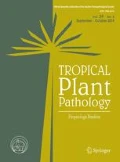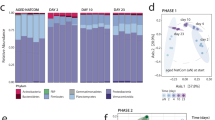Abstract
The plant pathogenic fungus Fusarium oxysporum f. sp. passiflorae (FOP) causes severe losses to the Brazilian passiculture. As a soil inhabitant, the fungus spreads at the micro spatial scale (microspread) via mycelial growth and colony expansion. The pathogen expansion rate is affected by the spatial distribution of inoculum sources available, as well as by environmental factors. The objective of this study was to model the in vitro dynamics of FOP by simulating its microspread, under the effect of pH and osmotic potential, in controlled physical environments formed by agar sites spatially distributed in a triangular lattice. An additional experiment evaluated the effect of a heterogeneous environment on FOP microspread. This setting was represented by different fractions of sites with high and low nutritional content. A percolation theory was used to determine the limits of pathogen spread where critical distances are associated with a critical probability of site colonization. The logistic dose-response model was fitted to growth curves with the parameters estimated based on non-linear regression. We found that nutritional state of sites affected FOP microspread. In particular, a heterogeneous environment reduced their rate of microspread and consequently could reduce epidemic progress rate. This study contributes new biological knowledge and information to further improve disease management.










Similar content being viewed by others
Data availability
The data may be made available for consultation or confirmation upon request.
References
Alhussaen KM (2012) Effect of soil acidity on diseases caused by Pythium ultimum and Fusarium oxysporum on tomato plants. Journal of Biological Sciences 12:416–420
Bailey DJ, Otten W, Gilligan CA (2000) Saprotrophic invasion by the soil-borne fungal plant pathogen Rhizoctonia solani and percolation thresholds. New Phytologist 146:535–544
Barnett HL, Hunter BB (1998) Illustrated genera of imperfect fungi, 4th edn. The American Phytopathological Society, Minnesota
Bianconi G (2017) Epidemic spreading and bond percolation on multilayer networks. Journal of Statistical Mechanics: Theory and Experiment 2017:034001
Bunde A, Havlin S (1991) Percolation. In: Bunde A, Havlin S (eds) Fractals and disordered systems. Springer Verlag, New York, pp 51–146
Carvalho ADOD, Jacob Neto J, Carmo MGFD (2005) Colonização de raízes de tomateiro por Fusarium oxysporum f. sp. lycopersici em solução nutritiva com três fontes de nitrogênio. Fitopatologia Brasileira 30:26–32
Carvalho AB, Coelho VJ, Araújo KL, Siqueira KA, Neves SMAS, Soares MA, Neves LG (2015) Genetic variability of Fusarium solani and Fusarium oxysporum f. sp. passiflorae isolates from Pantanal, Amazon and Cerrado biomes of Mato Grosso, Brazil. African Journal of Agricultural Research 10:4990–4997
Chayes L, Schonmann RH (2000) Mixed percolation as a bridge between site and bond percolation. The Annals of Applied Probability 10:1182–1196
Fang X, You M, Barbetti M (2012) Reduced severity and impact of fusarium wilt on strawberry by manipulation of soil pH, soil organic amendments and crop rotation. European Journal of Plant Pathology 134:619–629
Ferrin DM, Stanghellini ME (2006) Effect of water potential on mycelial growth and perithecial production of Monosporascus cannonballus in vitro. Plant Pathology 55:421–426
Fischer IH, Rezende JAM (2008) Diseases of passion flower (Passiflora spp.). Pest Technology 2:1–19
Furtado EL, Bueno CJ, Oliveira DAL, Menten JOM, Malavolta E (2009) Relações entre ocorrência do Mal-do-Panamá em bananeira da cv. Nanicão e nutrientes no solo e nas folhas. Tropical Plant Pathology 34:211–215
Gordon TR, Stueven M, Pastrana AM, Henry PM, Dennehy CM, Kirkpatrick SC, Daugovish O (2019) The effect of PH on spore germination, growth and infection of strawberry roots by Fusarium oxysporum f. sp. fragariae, cause of fusarium wilt of strawberry. Plant Disease 103:697–704
Grassberger P (1983) On the critical behavior of the general epidemic process and dynamical percolation. Mathematical Biosciences 63:157–172
Grimmett G (1999) Percolation, 2th edn. Springer-Verla, Berlin
Huang J, Pang Y, Zhang F, Huang Q, Zhang M, Tang S, Fu H, Li P (2019) Suppression of Fusarium wilt of banana by combining acid soil ameliorant with biofertilizer made from Bacillus velezensis H-6. European Journal of Plant Pathology 154:585–596
Ishikawa T, Hayakawa T (2001) On equivalence between critical probabilities of dynamic gossip protocol and static site percolation. SICE Journal of Control, Measurement and System Integration 4:254–259
Jandel S (1991) TableCurve: curve fitting software. Jandel Scientific, Corte Madera
Lavelle P, Spain AV (2005) Soil ecology, 2th edn. Springer Science & Business Media, Dordrecht
Li BL, Loehle C, Malon D (1996) Microbial transport through heterogeneous porous media: random walk, fractal, and percolation approaches. Ecological Modelling 85:285–302
Ludlam JJ, Gibson GJ, Otten W, Gilligan CA (2012) Applications of percolation theory to fungal spread with synergy. Journal of the Royal Society Interface 9:949–956
Meyers LA, Newman MEJ, Martin M, Schrag S (2003) Applying network theory to epidemics: control measures for Mycoplasma pneumoniae outbreaks. Emerging Infectious Diseases 9:204–210
Michel BE, Radcliffe D (1995) A computer program relating solute potential to solution composition for five solutes. Agronomy Journal 87:126–130
Neri FM, Bates A, Füchtbauer WS, Pérez-Reche FJ, Taraskin SN, Otten W, Bailey DJ, Gilligan CA (2011) The effect of heterogeneity on invasion in spatial epidemics: from theory to experimental evidence in a model system. PLoS Computational Biology 7:e1002174
Otten W, Gilligan CA, Watts CW, Dexter AR, Hall D (1999) Continuity of air-filled pores and invasion thresholds for a soil-borne fungal plant pathogen, Rhizoctonia solani. Soil Biology and Biochemistry 31:1803–1810
Otten W, Bailey DJ, Gilligan CA (2004) Empirical evidence of spatial thresholds to control invasion of fungal parasites and saprotrophs. New Phytologist 163:125–132
Palacios S, Casasnovas F, Ramirez ML, Reynoso M, Torres AM (2014) Impact of water potential on growth and germination of Fusarium solani soilborne pathogen of peanut. Brazilian Journal of Microbiology 45:1105–1112
Pane C, Spaccini R, Piccolo A, Scala F, Bonanomi G (2011) Compost amendments enhance peat suppressiveness to Pythium ultimum, Rhizoctonia solani and Sclerotinia minor. Biological Control 56:115–124
Pinheiro GS, Cajuhi LF, de Souza Guimarães AL, Rosa RCC, Laranjeira FF (2016) Identificação e modelagem do risco de fatores químicos e físicos à incidência da fusariose do maracujazeiro na Bahia. Revista Brasileira de Geografia Física 9:1168–1182
Rathore SS, Saxena SN, Shrma YK, Mishra BK, Singh S (2015) Effect of pH and salt levels on growth of Fusarium oxysporum f. sp.cumini isolate from cumin. International Journal of Seed Spices 5:100–101
Silva ADS, Oliveira EJD, Haddad F, Jesus OND, Oliveira SASD, Costa MAPC (2013) Molecular fingerprinting of Fusarium oxysporum f. sp. passiflorae isolates using AFLP markers. Scientia Agricola 70:108–115
Stauffer D, Aharony A (1994) Introduction to percolation theory. Taylor & Francis Ltd., London
Subbarao KV, Michailides TJ, Morgan DP (1993) Effects of osmotic potential and temperature on growth of two pathogens of figs and a biocontrol agent. Phytopatology 83:1454–1459
Tyagi S, Paudel R (2014) Effect of different pH on the growth and sporulation of Fusarium oxysporum: the causal organism of wilt disease of tomato. International Journal of Basic and Applied Biology 2:103–106
Young IM, Crawford JW, Nunan N, Otten W, Spiers A (2008) Microbial distribution in soils: physics and scaling. Advances in Agronomy 100:81–121
Zhu Y, Lujan PA, Wedegaertner T, Nichols R, Abdelraheem A, Zhang JF, Sanogo S (2020) First report of Fusarium oxysporum f. sp. vasinfectum race 4 causing fusarium wilt of cotton in New Mexico, USA. Plant Disease 104:588–588
Acknowledgements
To Anne Bates (University of Cambridge) for her valuable tips on agar dots. We are also indebted to Dr. Franco Maria Neri (European Food Safety Authority - EFSA) for his tips on agar dots and modeling, as well as for reviewing the final version of the manuscript.
Funding
GSL received scholarship grant from the Coordenação de Aperfeiçoamento de Pessoal de Nível Superior (CAPES, Brazil). FFL received research productivity grant from CNPq (307442/2013-6).
Author information
Authors and Affiliations
Contributions
Francisco Ferraz Laranjeira conceptualized the study, performed analyses, supervised experiments, revised, and edited the manuscript. Graziele Santos Lima prepared the material, performed analyses, and wrote the first draft of the manuscript. Leandro de Souza Rocha and Hermes Peixoto Santos Filho supervised experiments. Sami Jorge Michereff revised and edited the manuscript. All authors read and approved the final manuscript.
Corresponding author
Ethics declarations
Conflict of interest
The authors declare no competing interests.
Additional information
Publisher’s note
Springer Nature remains neutral with regard to jurisdictional claims in published maps and institutional affiliations.
Supplementary information
ESM 1
(DOCX 98 kb)
Rights and permissions
About this article
Cite this article
Lima, G.S., de Souza Rocha, L., Santos-Filho, H.P. et al. Modeling the spread of Fusarium oxysporum f. sp. passiflorae in simulated physical microenvironment. Trop. plant pathol. 46, 282–293 (2021). https://doi.org/10.1007/s40858-021-00425-5
Received:
Accepted:
Published:
Issue Date:
DOI: https://doi.org/10.1007/s40858-021-00425-5




